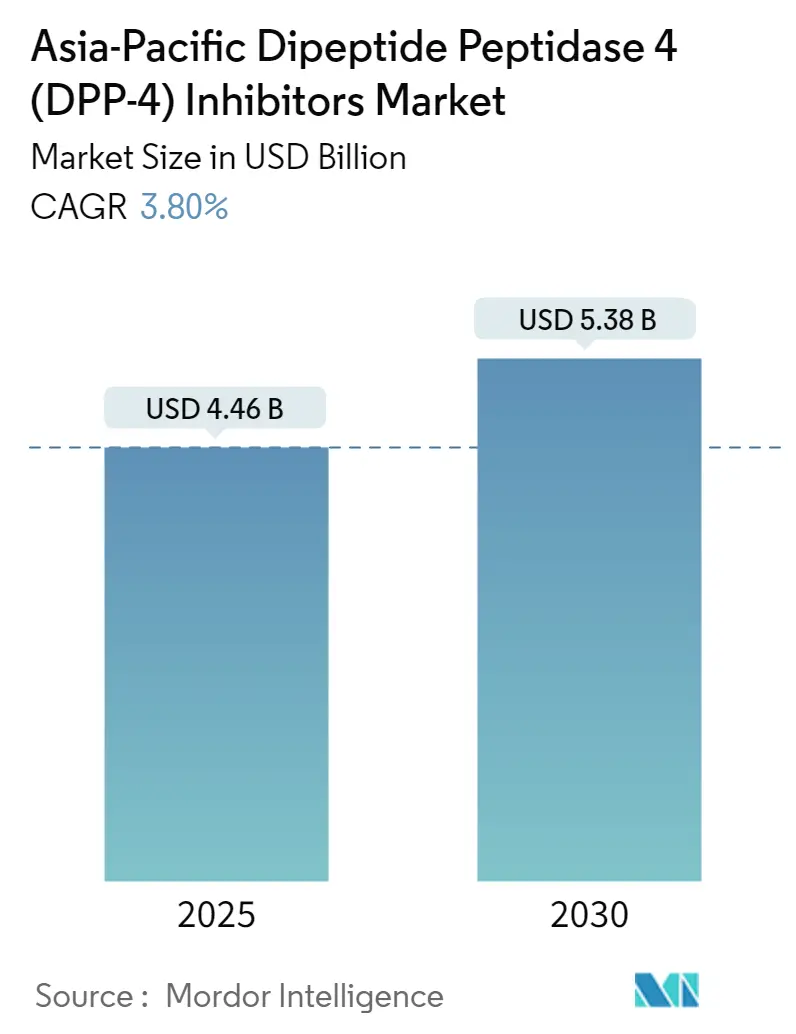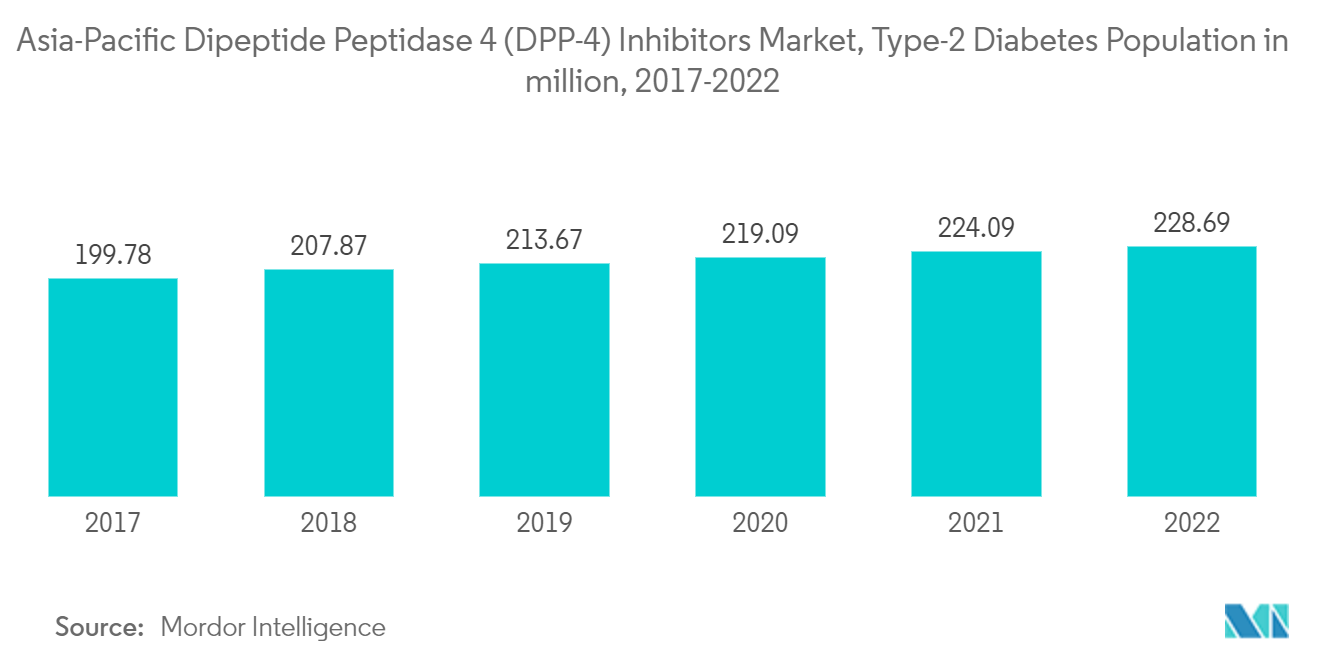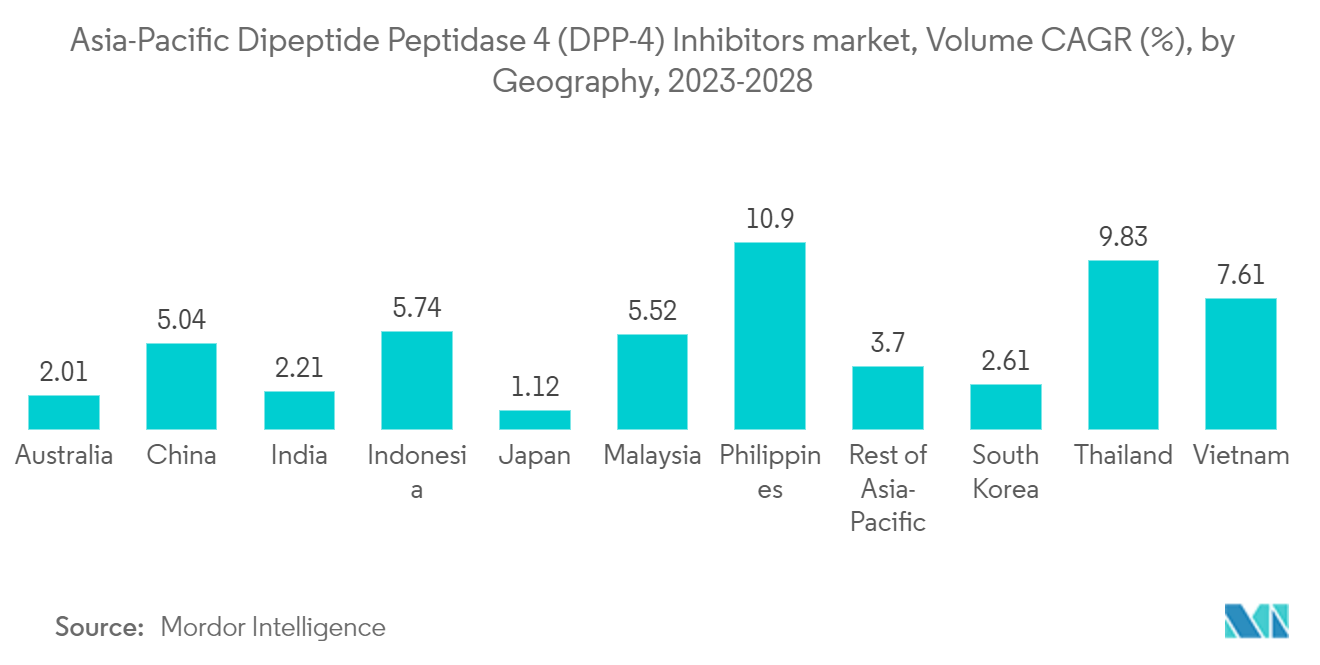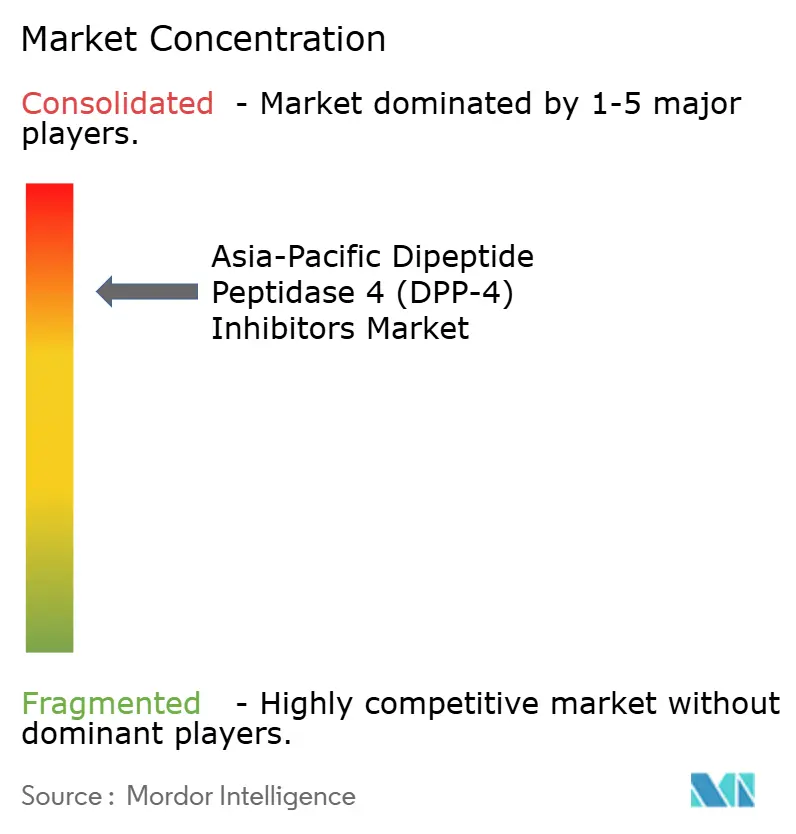
Asia-Pacific Dipeptide Peptidase 4 (DPP-4) Inhibitors Market Analysis by Mordor Intelligence
The Asia-Pacific Dipeptide Peptidase 4 (DPP-4) Inhibitors Market size is estimated at USD 4.46 billion in 2025, and is expected to reach USD 5.38 billion by 2030, at a CAGR of 3.8% during the forecast period (2025-2030).
The COVID-19 pandemic positively impacted the Asia-Pacific Dipeptide Peptidase 4 (DPP-4) Inhibitors Market. Diabetes and uncontrolled hyperglycemia are risk factors for poor outcomes in patients with COVID-19 including an increased risk of severe illness or death. People with diabetes have a weaker immune system, the COVID-19 complication aggravates the condition, and the immune system gets weaker very fast. In the current crisis, type 2 diabetes patients are at much higher risk.
Dipeptidyl peptidase 4 (DPP-4) inhibitors are a class of medicine that lower high blood glucose levels and are used in the treatment of type 2 diabetes. DPP4 inhibitors increase insulin and GLP-1 secretion and are commonly prescribed for people suffering from type 2 diabetes. The use of DPP4 inhibitors in patients with COVID-19 with or even without type 2 diabetes offers a simple way to reduce the virus entry and replication into the airways and to hamper the sustained cytokine storm and inflammation within the lung in patients diagnosed with COVID-19 infection.
The COVID-19 pandemic emphasizes the need for good glycemic control in patients with diabetes, in large part because most observational studies have reported that poorly controlled diabetes is associated with a higher risk for hospitalization and death from a viral illness. Diabetes mellitus has been of wide concern with its high prevalence, resulting in increased financial burdens for clinical systems, individuals, and governments. The market players are adopting various strategies such as collaborations, partnerships, mergers, acquisitions, and expansions to increase market share. Technological advancements have increased over the period leading to several modifications either in the DPP-4 Inhibitor drugs or the formulations being developed.
Therefore, owing to increased diabetes prevalence and the aforementioned factors the studied market is anticipated to witness growth over the analysis period.
Asia-Pacific Dipeptide Peptidase 4 (DPP-4) Inhibitors Market Trends and Insights
The Tradjenta segment is expected to witness the highest CAGR in the Asia-Pacific dipeptide peptidase 4 (DDP-4) inhibitors market over the forecast period
The Tradjenta segment is expected to witness the highest CAGR of around 7% in the Asia-Pacific dipeptide peptidase 4 (DDP-4) inhibitors market over the forecast period.
Tradjenta is a prescription drug that helps improve blood glucose control in adults with type 2 diabetes and is considered an adjunct treatment to diet and exercise. It is also used as an add-on therapy to insulin. Tradjenta should not be used in patients with type 1 diabetes or for treating diabetic ketoacidosis. DPP-4 inhibitors are widely prescribed in Asian countries, in general, and are the most prescribed class of oral glucose-lowering drug in Japan. Drug class, patient characteristics, and severity of renal impairment characterize the persistence of oral anti-diabetic treatment for type 2 diabetes. Unlike older glucose-lowering drugs such as sulfonylureas and insulin, DPP-4 inhibitors contain an inherently low risk of causing hypoglycemia. It is due to their glucose-dependent insulinotropic mechanism of action mediated via the incretin hormone glucagon-like peptide-1.
The Asia-Pacific region witnessed an alarming increase in the prevalence of diabetes in recent years. In developing countries, such as China and India, the rate of diabetes is at an all-time high. Diabetes is associated with many health complications. Patients with diabetes require many corrections throughout the day to maintain nominal blood glucose levels, such as oral anti-diabetic medication or ingestion of additional carbohydrates by monitoring their blood glucose levels. The rapidly increasing incidence and prevalence of diabetic patients and healthcare expenditure are indications of the increasing usage of diabetic drugs. The use of oral anti-diabetes drugs is rising because new-generation oral drugs, such as DPP-4 and SGLT-2, reduce the rate of CV risk in diabetes patients.
Owing to the factors mentioned above, the market is likely to grow.

China holds the highest market share in the Asia-Pacific Dipeptide Peptidase 4 (DPP-4) Inhibitors Market in the current year
China holds the highest market share of about 41.8% in the Asia-Pacific Dipeptide Peptidase 4 (DPP-4) Inhibitors Market in the current year.
As per the IDF 2021 report, an estimated 141 million adults were living with diabetes in China, a rise of 20% over the past two years. Over half (50.5%) of adults living with diabetes in China are undiagnosed. 90% of people with diabetes contain type 2 diabetes. The rise in the number of people with type 2 is driven by a complex interplay of socio-economic, demographic, environmental, and genetic factors. Key contributors include urbanization, an aging population, decreasing levels of physical activity, and increased levels of overweight and obesity. Evidence suggests that type 2 diabetes can often be prevented. In contrast, early diagnosis and access to appropriate care for all types of diabetes can avoid or delay complications in people with the condition.
When diabetes is undetected or inadequately treated, people with diabetes are at risk of serious and life-threatening complications, such as heart attack, stroke, kidney failure, blindness, and lower-limb amputation. These result in reduced quality of life and higher healthcare costs. China significantly improved the detection and management of diabetes with its pilot projects in NDAs (National Demonstration Areas) and its attempts to improve health system integration. These initiatives demonstrate a willingness to confront the rise of diabetes with strategies based on health promotion, disease detection, and managing the multiple conditions and complications associated with the disease.
Therefore, owing to the factors above, the growth of the studied market is anticipated in the Asia-Pacific Region.

Competitive Landscape
The Asia-Pacific Dipeptide Peptidase 4 (DPP-4) Inhibitors market is consolidated, with a few major manufacturers like Eli Lilly, AstraZeneca, Merck, and Novartis, gaining presence in major countries. In contrast, the remaining market comprises other local or region-specific manufacturers.
Asia-Pacific Dipeptide Peptidase 4 (DPP-4) Inhibitors Industry Leaders
-
AstraZeneca
-
Eli Lilly and Company
-
Merck and Co.
-
Novartis AG
-
Bristol-Myers Squibb
- *Disclaimer: Major Players sorted in no particular order

Recent Industry Developments
- July 2022: Glenmark Pharmaceuticals Limited announced the launch of sitagliptin and its fixed-dose combinations for adults with Type 2 diabetes in India. Glenmark introduced 8 different combinations of sitagliptin-based drugs under the brand name SITAZIT and its variants at an affordable price.
- May 2022: As Januvia/Janumet (sitagliptin), a Merck & Co drug, nears patent expiry, India's drug price regulator National Pharmaceutical Pricing Authority (NPPA), fixed the prices of fixed-dose combinations of several anti-diabetic drugs with a 50% reduction on the patented component.
Asia-Pacific Dipeptide Peptidase 4 (DPP-4) Inhibitors Market Report Scope
Dipeptidyl peptidase 4 (DPP-4) inhibitors are a pharmacological class for treating Type 2 diabetes. They help to control glycemia by increasing the levels of active incretins. The Asia-Pacific Dipeptide Peptidase 4 (DPP-4) Inhibitors Market is segmented into drugs (Sitagliptin (Januvia), Saxagliptin (Onglyza), Linagliptin (Tradjenta), Alogliptin (Vipidia/Nesina), Vildagliptin (Galvus), and others), and geography (Australia, China, India, Indonesia, Japan, Malaysia, Philippines, South Korea, Thailand, Vietnam, and rest of Asia-Pacific). The report offers the value (in USD million) and volume (in units million) for the above segments. Further, the report will cover a segment-wise breakdown (value and volume) for all the countries covered under the Table of Contents.
| Januvia (Sitagliptin) |
| Onglyza (Saxagliptin) |
| Tradjenta (Linagliptin) |
| Vipidia/Nesina (Alogliptin) |
| Galvus (Vildagliptin) |
| Others |
| Australia |
| China |
| India |
| Indonesia |
| Japan |
| Malaysia |
| Philippines |
| South Korea |
| Thailand |
| Vietnam |
| Rest of Asia-Pacific |
| Drug | Januvia (Sitagliptin) |
| Onglyza (Saxagliptin) | |
| Tradjenta (Linagliptin) | |
| Vipidia/Nesina (Alogliptin) | |
| Galvus (Vildagliptin) | |
| Others | |
| Geography | Australia |
| China | |
| India | |
| Indonesia | |
| Japan | |
| Malaysia | |
| Philippines | |
| South Korea | |
| Thailand | |
| Vietnam | |
| Rest of Asia-Pacific |
Key Questions Answered in the Report
How big is the Asia-Pacific Dipeptide Peptidase 4 (DPP-4) Inhibitors Market?
The Asia-Pacific Dipeptide Peptidase 4 (DPP-4) Inhibitors Market size is expected to reach USD 4.46 billion in 2025 and grow at a CAGR of 3.80% to reach USD 5.38 billion by 2030.
What is the current Asia-Pacific Dipeptide Peptidase 4 (DPP-4) Inhibitors Market size?
In 2025, the Asia-Pacific Dipeptide Peptidase 4 (DPP-4) Inhibitors Market size is expected to reach USD 4.46 billion.
Who are the key players in Asia-Pacific Dipeptide Peptidase 4 (DPP-4) Inhibitors Market?
AstraZeneca, Eli Lilly and Company, Merck and Co., Novartis AG and Bristol-Myers Squibb are the major companies operating in the Asia-Pacific Dipeptide Peptidase 4 (DPP-4) Inhibitors Market.
What years does this Asia-Pacific Dipeptide Peptidase 4 (DPP-4) Inhibitors Market cover, and what was the market size in 2024?
In 2024, the Asia-Pacific Dipeptide Peptidase 4 (DPP-4) Inhibitors Market size was estimated at USD 4.29 billion. The report covers the Asia-Pacific Dipeptide Peptidase 4 (DPP-4) Inhibitors Market historical market size for years: 2019, 2020, 2021, 2022, 2023 and 2024. The report also forecasts the Asia-Pacific Dipeptide Peptidase 4 (DPP-4) Inhibitors Market size for years: 2025, 2026, 2027, 2028, 2029 and 2030.
Page last updated on:



